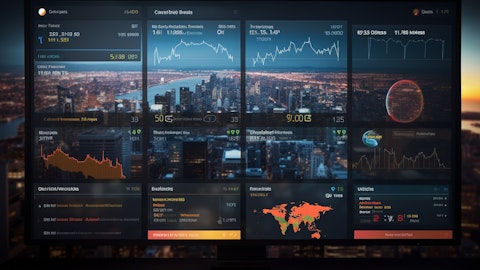And the last point on cookies, we said it from the beginning, we are based on contextually driven, our goals primarily, we have first-party data on our publishers that we leverage. So we don’t see a risk from the cookie application on a relative basis on the open internet, We think we actually have a big advantage versus other companies that are very focused on retargeting and need to track users across third-party sites. So for us its a relatively minimal impact on our algos when cookies go away. We tested it when Firefox deprecated it and it had minimal impact.
Laura Martin: Thank you very much.
Operator: Thank you. And we’ll take our next question from Zach Cummins from B Riley. Please go ahead, Zach.
Zach Cummins: Yes. Hi. Good morning. Thanks for taking my questions and congrats on the strong start to the year. I really wanted to dig in a little bit more on Onyx. I appreciate the disclosure with the $7 million in revenue here in Q1, but can you just talk about which customer side is this really resonating with and kind of what’s the strategy to continue to drive adoption on that side since it appears to be a pretty meaningful growth driver in the overall scheme?
Jason Kiviat: Thanks Zach for the question. So Onyx is targeting enterprise brands and agencies who are looking for to launch campaigns that build brands. So we’ve been very, very focused since our start on performance, but we see a huge opportunity to leverage a lot of our prediction capabilities and our unique supply to drive much better value also for brand building campaigns. I mean, there’s a good positive trend on the internet generally that also for brand building. advertisers are looking for measurable outcomes. We’ve been very focused on finding attention as the key metric and that leverage our heritage of prediction. This we launched it in the second half of last year. We had about $15 million in the second half of last year.
We see good growth getting into Q1 and Q2 of this year. And we believe that this will also position us in a very unique way on the open internet being able to provide a full cross funnel. If you think about just an example, take BMW. I mean, they could do with us a campaign that would promote a new engine with a super cool video. And then we understanding the interaction of the user with that campaign could drive performance or consideration of a new car and then on the bottom really drive a lead to their dealership. So being able to combine that is pretty unique. And we’re leveraging a our existing base of enterprise brands and advertisers to leverage them from driving performance also to brand building. And it’s opening new doors for us at the holding companies and very large enterprise brands that have not worked with us before.
So it’s a great opportunity to really that’s why we emphasize it as one of the most important growth drivers and uniquely positions us on the open internet.
Zach Cummins: Understood. That’s helpful. And just one more financial related question. In terms of the reaffirmed guidance that you given this year, Jason, can you parse out how should we be thinking about just expansion of the take rate versus overall growth in terms of gross revenue and kind of what’s the right way to think about seasonality and in progression, especially into the second half of the year?
Jason Kiviat: Yes, of course. So yes, maybe just a reminder on our forecast methodology. So what we do is we take current trends that we’re seeing, kind of right up until the timing here and we build seasonality on top of that based on our history that we know month to month and quarter to quarter what to expect over our 15-year history or so. And of course, layer on other known items or growth driver assumptions, et cetera. And it does come out all together as a slightly higher percentage of ex-TAC and H2 relative to H1. If you compare it to 2023, we’re 56% this year versus 53% was the actual last year, 56% if we’re using the midpoint of the guidance. And so, maybe breaking that down into a couple pieces. If you’re using the midpoint of the guidance close to half of that H2 growth is coming from easier comps and what I mean by that is, last year Q4 and really started with October, and the attacks on October 7 and the onset of the war, we saw just a smaller increase from Q3 to Q4 as a whole than we historically have seen.
We talked in prior quarters about the impact obviously on our local business in Israel, but also on our global business where much of the page use of our largest partners were temporarily showing lots of news about the war, which were, monetizing lower than they typically would due to brand safety concerns and things like that, right? So, we did see a softer Q4 last year, which sets us up for a little bit of an easier comp this year. And the other thing is, and I mentioned on the call about supply volatility from a key tech partner, we started to see changes from that partner over the course of ’23, but really Q4 was the first meaningful period of impact. And so, again, as we kind of play out this year, well, I mentioned on the call that we had a mid to high single digit growth, excluding this one partner on Ex-TAC this year in Q1, and we expect similar in Q2.
As we make our way into Q4, that your headwind subsides. And so, obviously also expecting some modest sequential growth in the coming months in that partner also, aids it as well. And the other things are just things that are in our model, obviously, we talked about our growth drivers, Onyx is one where we expected to be more seasonally Q4 focused than our core businesshas been historically. And then other things flowing through click through rates, we said, and yield growth for the last two quarters, continuing to flow through, we’ve seen strength in Europe, which we have flowing through in global events like the U.S. election, of course, will be a little bit of a lift in the second half of the year. So, hope that helps.
Zach Cummins: Yes, very, very helpful. So thank you so much for all the detail. And congrats again on solid results.
Jason Kiviat: Sure.
Operator: Thank you. And we’ll take our next question from Ygal Arounian from Citi. Please go ahead, Ygal.
Unidentified Analyst: Hey, guys, good morning. Max [ph] on for Ygal. Maybe first of you just give us some color on what you’re seeing in the ad macro. It seems like, we’ve seen a better start to 1Q. So just wondering what you’re seeing there with ad budgets, maybe that there’s any geographical or vertical strength and weaknesses to call out. And then, maybe more like a capital allocation question. But you mentioned the $232 million of cash investments on the balance sheet. Just wondering how you guys think about the cash position and understand the buyback authorization. But if there’s anything else you guys are thinking about on how to deploy that capital, whether it’s M&A or some other uses?



